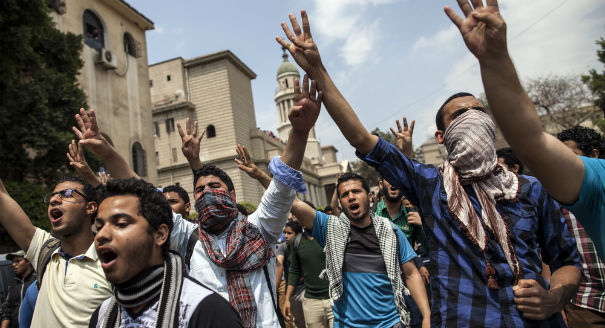After about a year of internal conflicts, the Muslim Brotherhood in Egypt has finally begun a comprehensive restructuring process. For the first time, the group is empowering its youth to lead the organization. This shift in approach reflects the former leadership’s realization that it has failed to adapt to domestic politics and Abdel Fattah el-Sisi’s crackdown since the ouster of Mohamed Morsi in July 2013.
The Muslim Brotherhood, in response to the crackdown, has conceded to the will of active youth members and others who support an escalation with the Sisi government. The shift came after Brotherhood youth finally refused to work with the group’s secretary-general, Mahmoud Hussein, who had sidelined them during Morsi’s administration. In order to placate the youth wing, and due to worries about the growing number of Egyptian youth joining radical groups such as the Islamic State, the Muslim Brotherhood allegedly sacked Hussein amid mounting criticism. The Muslim Brotherhood’s old guard worried that a major loss of youth supporters would sink the Muslim Brotherhood as both an ideology and an organization.
In response to these difficult circumstances and increasing pressure from the youth, the group’s leadership has restructured the organization based on internal elections that lasted two months—as they took place not just in Egypt but also Qatar, Turkey, Malaysia, and Sudan—and ended at the beginning of January. The most important changes to date were a shift toward decentralization, a focus on preaching and charity work, and the election of a new “committee to manage crisis and mobilization” (lajnat idarat al-azma wal-hirak).
Regarding the group’s decentralization, the best analogue for this new approach is the organizational structure of Hamas in Gaza, which was likely in the back of the leadership’s mind when they pursued the restructuring. Each organizational level will no longer refer back to the higher level before implementing a decision, provided consultations are held. Previously the norm was to request authorization or prior approval from the top leadership. The new system will also mean that actions can be taken speedily.
The leadership also merged a number of committees to reduce the number of party officials and curb the organization’s overall spending. In particular, committees pertaining to political action and online communications were reduced in favor of preaching, rights, and charity committees, which had been neglected under Morsi. But the more important change is the election of the committee to manage crisis and mobilization, which will pursue action to topple the Sisi government and that includes Brotherhood members from both at home and abroad.
To achieve this end, the Muslim Brotherhood’s youth are looking to restore ties with civic opposition movements with whom they protested alongside in the January 25 revolution. Brotherhood youth are trying to find ways to cooperate despite their base’s hostility toward some of the groups that called for Morsi’s removal. Joint committees from the two have already been in contact over the past month. Recent events have also supported this approach, especially after the January 25 killing of Shaima al-Sabbagh, an activist from the Socialist Popular Alliance party who was taking part in a peaceful march toward Tahrir Square to place flowers at the memorial for martyrs of the revolution.
Within the Muslim Brotherhood, the growing role of the youth will likely intensify the conflict, given Sisi’s complete rejection of the organization. Against the ongoing crackdown—more than 47,000 Egyptians are imprisoned, according to the Egyptian Coordination of Rights and Freedoms—the Brotherhood’s youth is growing more committed to revolutionary action. They have already raised slogans, such as “anything aside from bullets is peaceful,” calling for escalatory measures. These measures would include torching police headquarters and stations, government offices, public buses, and power plants, in addition to blocking vital roads.
These structural changes and shifts in approach already became evident during recent speeches and events in Egypt. On January 10, 2015 Salama Abdel Qawi, former spokesman for the Ministry of Religious Endowments under Morsi, issued a fatwa saying that “killing President Sisi or any of the ‘criminal leaders’ brings one closer to God. And if a person is killed while trying to kill Sisi, he is a martyr.” Moreover, on January 26, Egypt witnessed clashes between demonstrators resulting in 23 deaths in the Matriya district of northern Cairo. Matriya is one of the areas that have seen intense confrontations between the Brotherhood and security forces every Friday. Taken together, these types of incidents risk pushing Egypt and the Brotherhood itself into institutional and ideological violence, which would give the Sisi government an excuse to blame them for any past or future terror attacks.
Given the absence of any signs of an expansion of freedoms or reform of the state apparatus and judiciary, it is clear that the Egyptian crisis will grow more complex. Meanwhile, President Sisi’s offer to reconcile with the Muslim Brotherhood if it recognizes Sisi’s presidency and the legitimacy of the June 30 revolution remains on the table. He maintains that if these conditions are met, the majority of imprisoned group members will be released. If the Muslim Brotherhood takes up Sisi’s offer, however, the group risks alienating its youth base further. But if they forego the offer, the Muslim Brotherhood risks becoming a violent organization, perhaps eroding much of its traditional support base in the process.
Mostafa Hashem is an Egyptian journalist specializing in jihadi movements, political Islam, and youth issues.
*This article was translated from Arabic. It is the result of a series of interviews with Muslim Brotherhood leaders and youth.








